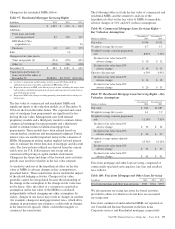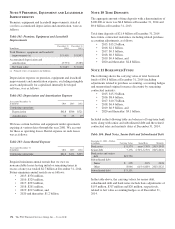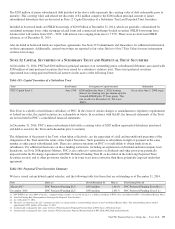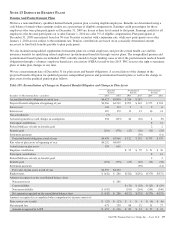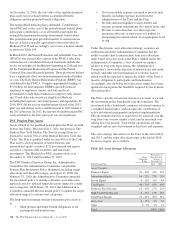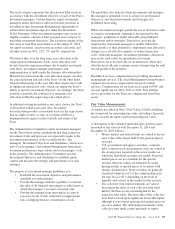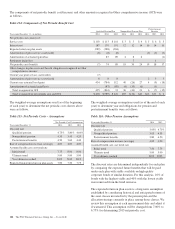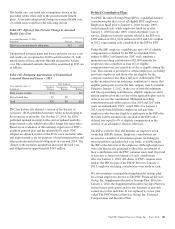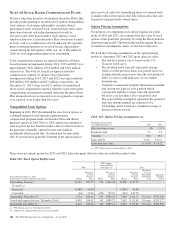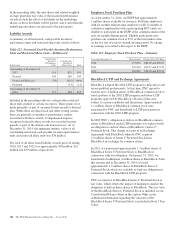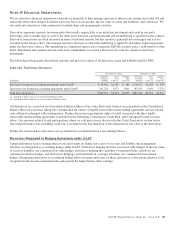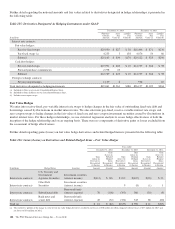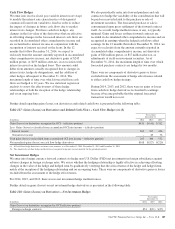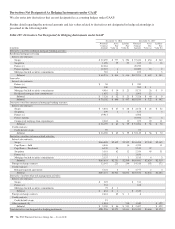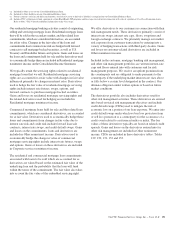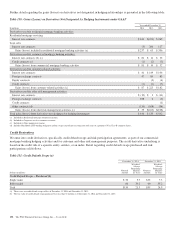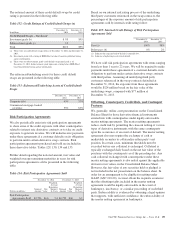PNC Bank 2014 Annual Report Download - page 201
Download and view the complete annual report
Please find page 201 of the 2014 PNC Bank annual report below. You can navigate through the pages in the report by either clicking on the pages listed below, or by using the keyword search tool below to find specific information within the annual report.
The health care cost trend rate assumptions shown in the
preceding tables relate only to the postretirement benefit
plans. A one-percentage-point change in assumed health care
cost trend rates would have the following effects.
Table 117: Effect of One Percent Change in Assumed
Health Care Cost
Year ended December 31, 2014
In millions Increase Decrease
Effect on year end benefit obligation $12 (10)
Unamortized actuarial gains and losses and prior service costs
and credits are recognized in AOCI each December 31, with
amortization of these amounts through net periodic benefit
cost. The estimated amounts that will be amortized in 2015 are
as follows.
Table 118: Estimated Amortization of Unamortized
Actuarial Gains and Losses – 2015
Year ended December 31
2015 Estimate
Qualified
Pension
Nonqualified
Pension
Postretirement
BenefitsIn millions
Prior service (credit) $ (9) $(1)
Net actuarial loss 29 $8
Total $20 $8 $(1)
PNC has historically utilized a version of the Society of
Actuaries’ (SOA) published mortality tables in developing its
best estimate of mortality. On October 27, 2014, the SOA
published updated mortality tables and an updated mortality
improvement scale, which both reflect longer life expectancy.
Based on an evaluation of the mortality experience of PNC’s
qualified pension plan and the updated SOA study, PNC
adopted an adjusted version of the SOA’s new mortality table
and improvement scale for purposes of measuring pension and
other postretirement benefit obligations at year-end 2014. The
change to the mortality assumption increased the total year-
end obligations by approximately $145 million.
Defined Contribution Plans
Our PNC Incentive Savings Plan (ISP) is a qualified defined
contribution plan that covers all eligible PNC employees.
Employees hired prior to January 1, 2010 became 100%
vested immediately, while employees hired on or after
January 1, 2010 become 100% vested after three years of
service. Employee benefits expense related to the ISP was
$108 million in 2014, $120 million in 2013 and $111 million
in 2012, representing cash contributed to the ISP by PNC.
Under the ISP, employee contributions up to 4% of eligible
compensation as defined by the ISP are matched 100%,
subject to IRS Code limitations. PNC will contribute a
minimum matching contribution of $2,000 annually for
employees who contribute at least 4% of eligible
compensation every pay period he or she is eligible during the
year. This amount is prorated for certain employees, including
part-time employees and those who are eligible for the
company match for less than a full year. Additionally, PNC
makes an annual true-up matching contribution to ensure that
eligible participants receive the full company match available.
Effective January 1, 2012, in the case of both the minimum
and true-up matching contributions, eligible employees must
remain employed on the last day of the applicable plan year in
order to receive the contribution. Minimum matching
contributions made with respect to the 2014 and 2013 plan
years are immediately 100% vested. Effective January 1,
2015, newly-hired full-time employees and part-time
employees who become eligible to participate in the ISP after
that date will be automatically enrolled in the ISP with a
deferral rate equal to 4% of eligible compensation in the
absence of an affirmative election otherwise.
The ISP is a 401(k) Plan and includes an employee stock
ownership (ESOP) feature. Employee contributions are
invested in a number of investment options, including pre
mixed portfolios and individual core funds, available under
the ISP at the direction of the employee. Although employees
were also historically permitted to direct the investment of
their contributions into the PNC common stock fund, this fund
was frozen to future investments of such contributions
effective January 1, 2010. All shares of PNC common stock
held by the ISP are part of the ESOP. Effective January 1,
2011, employer matching contributions were made in cash.
We also maintain a nonqualified supplemental savings plan
for certain employees, known as The PNC Financial Services
Group, Inc. Supplemental Incentive Savings Plan. Effective
January 1, 2012, the Supplemental Incentive Savings Plan was
frozen to new participants and for any deferrals of amounts
earned on or after such date. It was replaced by a new plan
called The PNC Financial Services Group, Inc. Deferred
Compensation and Incentive Plan.
The PNC Financial Services Group, Inc. – Form 10-K 183


